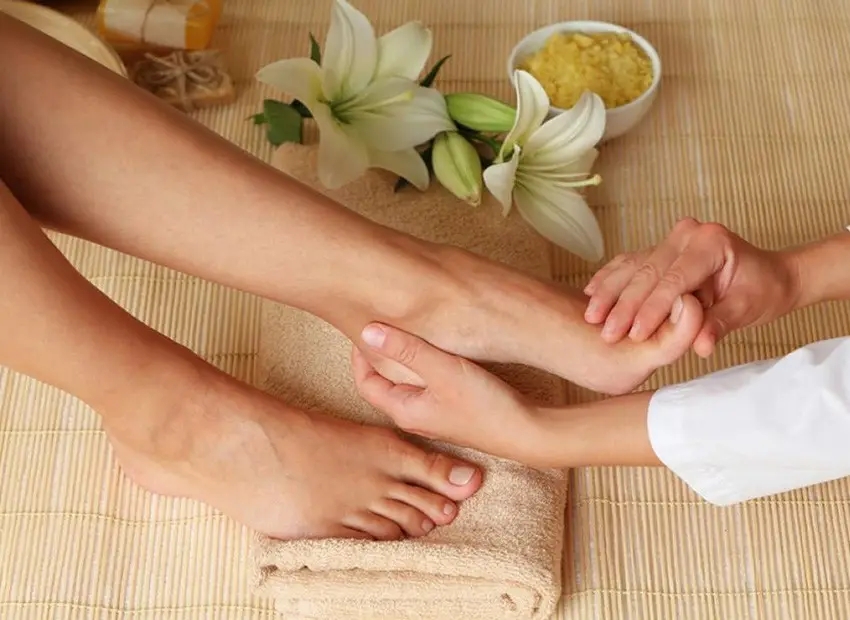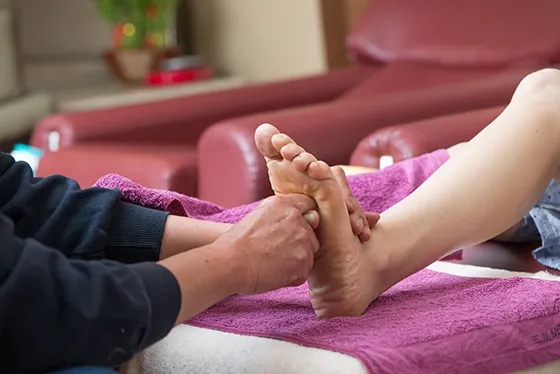The Massage Provider and Protocol
In the study, you received foot massage from a nurse “experienced in the administration of massage.” This sometimes raises eyebrows among massage therapists who ask about credentials and whether this truly reflects massage therapy practice. In this case, the authors wanted to restore massage to nursing care when needed, not try to pass off a nursing intervention as massage therapy. But, their description of the massage, a very detailed, fixed protocol, suggests that the authors clearly understand some of the important essentials of massage. This is the massage session described by Grealish, et al. “The massage was performed using slow, firm or gentle strokes toward the heart, from the base of the toes up the foot and lower leg to the knee … The fingertips were used to make small circular movements around joints and between deep and superficial muscles, including the ankle, and between the metatarsals. A rhythmic lifting and squeezing of the flesh using both hands was alternated with the other movements. Joints were rotated in a clockwise and counterclockwise direction three times. When doing massage, the nurse’s hands were warm. The foot not being massaged was covered with a towel and the massaged foot was held firmly. A non-fragrant vegetable oil was used.”
Two things are important to note about the protocol. First, the title of the study depicts “foot massage,” yet it included both foot and low leg. In fact, “foot massage” might have been good shorthand for the study, but this discrepancy suggests it’s important to read what actually happened in the session. I meet MTs in my trainings who claim to be allergic to reading research, but even they become engaged when flipping through a study to read the actual massage protocol. Second, this massage protocol is very clear. This is one of my favorite massage research protocols because it describes so clearly what actually happened. I can imagine each toe being rotated three times in each direction! The researchers clearly share practices with massage therapists and note them in the study. Cover the nonmassaged area with a towel. Firm touch matters. The kind of oil you use bears mentioning. Moreover, each patient received an “introductory massage” before the study began, so they would know what to expect. These things suggest the researchers understand important elements such as safety, warmth, depth and firm touch. Regardless of whether I agree with their choice of protocol, the description is so clearly written I could easily replicate it in practice, especially if good things seem to come from it!

Measurements and Findings
The authors measured immediate effects of massage, not sustained or long-term effects. They asked questions just prior to the massage, and then 20 minutes after it was over. On the control night, they did the same, but left the patient in a quiet activity, and then measured again 20-30 minutes later.
Three “subjective outcomes” (pain, nausea and relaxation) and one “objective outcome” (heart rate, a function of relaxation) were measured in this study. Patients were asked to complete three “visual analogue scales” before and after each condition. On a 100 mm line, showing “no pain” at 0 mm and “worst possible pain” at 10 mm, patients were asked to mark their symptom level on the scale. Somewhat similar scales were used for relaxation and nausea. While subjective, the VAS is a convenient measurement tool that therapists easily can incorporate into clinical practice, before and after the session.

The study found that immediate self-reports of pain and nausea dropped on the massage nights compared to the control nights. Relaxation appeared to increase after massage, shown in heart rates and self-reports. This was associated with only two short foot massages; perhaps a greater effect would occur with a higher massage therapy dose. In their discussion, the authors note the positive findings. But, instead of making sweeping, grandiose claims of benefit, they list limitations of their own study and directions for further research. (A humble tone is a good sign in a research paper; look for it any time you read the discussion section.) We should follow their lead and not overstate results. This study still is relatively small – 87 in the sample – although it’s one of the largest of the small studies. We need a larger body of research evidence before we truly can claim, “The evidence shows massage helps symptoms.” For now, we can state that small “controlled trials” (as both Grealish and Post-White provide, with control conditions and good design) are “beginning to suggest a relationship between massage and symptom relief.” This study, along with some other solid contributions, is beginning to point the way. Cautious claims aside, let’s focus on the individual stories again. If you were a patient whose nausea or pain subsided, would you insist on the data to support your experience? Probably not. You would simply feel better. Perhaps you’d feel grateful for having your feet and low legs massaged with firm, warm hands. Your single story is worth telling, too. Indeed, individual stories are as compelling as the group story here. All should be examined closely and noted, told and retold. Each story contributes something to our understanding of massage and symptom relief.
